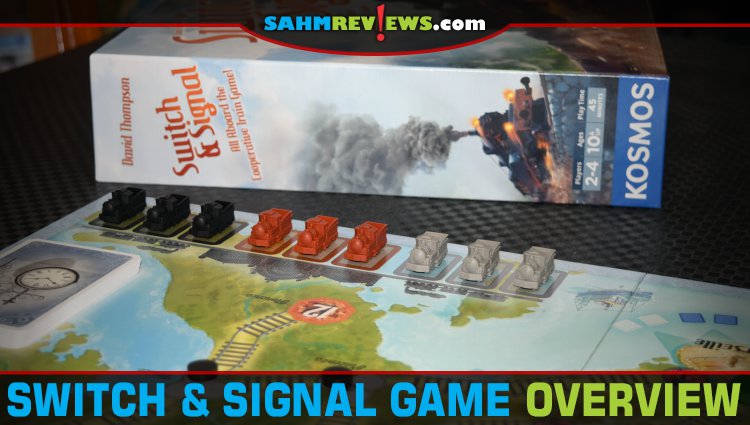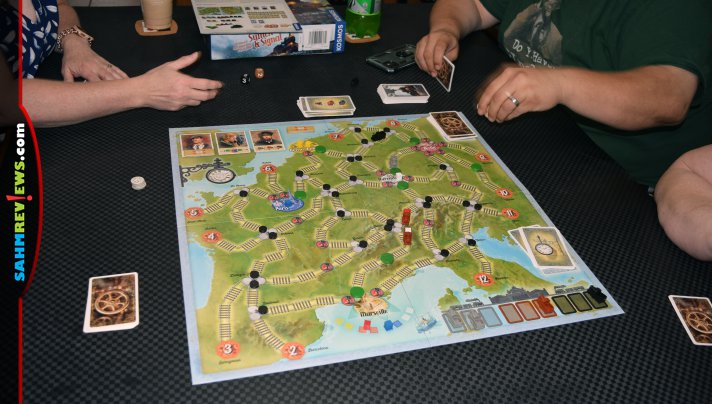Switch & Signal Cooperative Train Game Overview

As you know, we game regularly on weekends. Our standard game is Gloomhaven, but we’re really at the tail end of it so we’ve been stretching the last few sessions out by playing other games. Scott and Doug often select from some of the games we have queued for coverage here on SAHM Reviews. Other times, we pull out an old favorite like Lorenzo il Magnifico or The Crew because I love those. But there are four of us that play and Sandy is a huge fan of train games. So every once in a while, we’ll dig out something that we know will be a hit for her. Recently, we played Switch & Signal from KOSMOS.

The idea behind the game is that everyone is working together to get the goods delivered to the port. You do this by using the available train routes through Central Europe or North America. The catch is that you only have so much time to do it and you don’t have as much control of the trains as you might like. Set up by selecting which map you would like to play. Place the switch and signal discs as well as the goods on the designated spaces. Time tokens are added to the clock face and will be used to control the length of the game. Card decks are shuffled and dealt as noted, dice are set out and trains are docked in the depot. You’re pretty much ready to go!

Each player is dealt five cards which are used for train movement, changing the signals and switch locations and loading goods. You can use as few or as many as you want then at the end of your turn, you’ll draw five more cards into your hand until you reach the hand limit of 10.

Each turn consists of three phases: Revealing a departure card, playing action cards then drawing new ones. During the first phase, you’ll draw a departure card and follow the instructions from top to bottom. It may indicate that you’ll need to deploy new trains or move the ones already on the board. You’ll roll the designated dice to indicate which location a train will start their journey or how far certain trains will move.

So far, it sounds pretty simple. The problem is that trains don’t just get to go where they want. When a train movement occurs (either by the departure or from playing an action card), you’ll roll the matching dice color then move the train(s) exactly that number of spaces. If it can’t for some reason, you’ll remove time tokens. What types of things keep a train from completing the movement? Other trains for one. In addition, there are signals that allow trains to move into and out of cities. You’ll need to play cards to rotate where those green lights go! If a train moves toward a city and it doesn’t have a green “go” signal to enter, it cannot. The same holds true for switches. They are designed to keep trains headed on specific routes. If you need to get a train to a specific destination, you’ll need to play cards to ensure the switches are set to send it where you want.

You aren’t simply moving trains around the board willy-nilly. Your goal is to pick up cargo and get it delivered to the port. That means directing the trains into and out of cities with cargo that needs to be picked up. Then spending an action card to pick one up.

Once a train arrives at the port, the cargo is safely delivered and the train returned to the port station. You need to get all the goods delivered by the end of the turn where the final departure card is played. Timer tokens are removed when a train cannot make its complete movement, a train isn’t available to be deployed, trains run into a starting location or collide head-on with one another. Each time the stack of timer tokens runs out, another card from the departure stack is removed, thus shortening the game. So act carefully yet quickly to get everything done.
As with most successful cooperative games, losing is part of the process. If it’s too easy, you won’t want to play again. Since train placement and movement often are left to chance either from the draw of the deck or the roll of the dice, the game can be quite unpredictable. That’s part of what makes it fun. And because it’s cooperative, you can easily incorporate younger players into the game. Pick up a copy of Switch & Signal at your local game store, direct from Kosmos or on Amazon. But don’t expect to win the first time so make plans to play it more than once! Switch over to their social channels (Facebook, Twitter) to get signals about other upcoming releases, too.
Do you prefer train games that are cooperative or competitive?





I do like that this is a cooperative game where players have to work together to get good to port.
I like cooperative train games. It’s fun to work together with others.
I like both.
I prefer cooperative. (It’s easier to get my husband to play with me)
I like both kinds!
It looks like a good learning game for kids.
I prefer cooperative games most of the time.
I prefer competitive train games. I’ve only played ticket to ride and another one that has stocks and is partially cooperative. I enjoy ticket to ride more.
I’m competitive, so I would enjoy the train themed games that are competitive.
Train games seem to imply competitive, and that is the way I think I’d prefer them.
competitive
I like both.